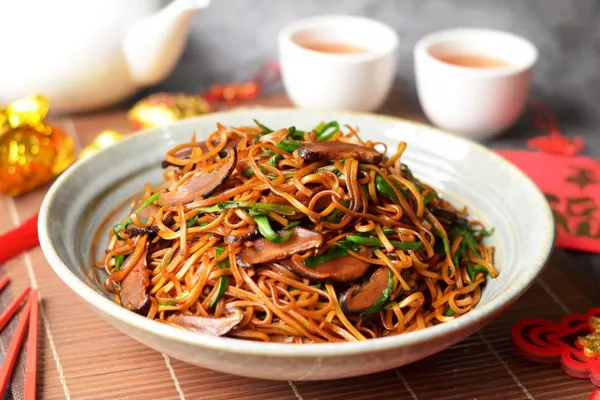If you walk down the noodle aisle at an Asian supermarket, chances are you’ll come across several types of Chinese noodles. Some are made from wheat, while others are made from rice, mung beans, or potatoes. The varieties, sizes and shapes of Chinese noodles are dizzying. Thin, thick, narrow, wide – the options are endless.
Origin of Noodles
China is often credited with the invention of noodles. The earliest known mention of noodles dates back to around 3000 BCE in a book titled “Shi Jing,” which includes a reference to “bing,” a type of wheat noodle. The archaeological record also provides evidence of noodles in China. A bowl containing well-preserved 4,000-year-old noodles was unearthed in northwestern China’s Qinghai province.
12 Types of Chinese Noodles
1. Wheat Vermicelli (Misua)
Wheat Vermicelli, commonly known as Misua, is a type of thin noodle made from wheat flour. It is a popular ingredient in various Asian cuisines, particularly in Chinese, Taiwanese, and Filipino dishes. Misua is distinct for its delicate and tender texture, which makes it a versatile choice for soups, stir-fries, and other noodle-based recipes.
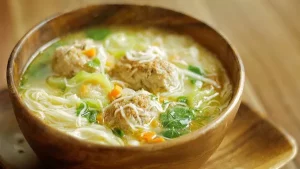
Characteristics of Wheat Vermicelli (Misua):
Appearance: Misua noodles are extremely thin and delicate, often resembling fine threads. They are usually pale yellow or light beige in color.
Texture: One of the defining features of Misua is its soft and tender texture. Unlike some other types of noodles, Misua cooks quickly and can become quite soft in a short amount of time.
Ingredients: Traditional Misua is made from wheat flour and water. The dough is often kneaded and pulled to create the thin strands. Some variations might include egg in the dough mixture, giving the noodles a slightly richer flavor and a subtle yellow hue.
Culinary Use: Misua is commonly used in soups and stir-fries. Due to its delicate nature, it’s important not to overcook Misua, as it can become mushy. It’s often added to broth-based soups, where it absorbs the flavors of the broth while maintaining its soft texture.
Cooking Tips:
- Quick Cooking: Due to their thinness, Misua noodles cook very quickly. Boil them for only a few minutes until they’re tender, and then drain and rinse them with cold water to prevent them from sticking together.
- Avoid Overcooking: Be cautious not to overcook Misua, as they can become mushy and lose their delicate texture.
- Adding to Soups: To add Misua to soups, it’s best to cook the noodles separately and then add them to the soup just before serving. This helps maintain their texture and prevents them from absorbing too much liquid.
- Stir-Frying: Misua can also be stir-fried with vegetables, meat, and sauces. Since it’s delicate, stir-fry it briefly to avoid breaking the noodles.
2. Lo Mein Noodles
Lo Mein noodles are a beloved staple in Chinese cuisine that has captured the hearts and palates of people around the world. This iconic dish features stir-fried noodles combined with a flavorful medley of vegetables, protein, and a savory sauce.
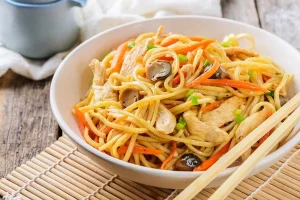
Characteristics of Lo Mein Noodles:
Noodle Type: Lo Mein noodles are typically made from wheat flour and egg, which gives them a slightly chewy and springy texture. The noodles are round and medium-thick, allowing them to hold up well to stir-frying.
Preparation: These noodles are boiled until they reach the desired level of doneness before being stir-fried with the other ingredients.
Flavor Absorption: One of the defining features of Lo Mein is the way the noodles absorb the flavors of the sauce and ingredients they’re cooked with.
Ingredients and Variations:
Vegetables: Lo Mein commonly includes a variety of vegetables such as bell peppers, broccoli, carrots, mushrooms, snow peas, and bok choy. The vegetables contribute both flavor and texture to the dish.
Protein: The protein component of Lo Mein can vary widely. Popular options include chicken, beef, shrimp, pork, or tofu. The protein is often marinated and cooked separately before being combined with the noodles and vegetables.
Sauce: A savory sauce is a crucial element of Lo Mein. It typically includes a combination of soy sauce, oyster sauce, sesame oil, and sometimes hoisin sauce. This sauce infuses the dish with its distinct umami flavor.
3. Teochew Flat Noodles (Mee Pok)
Mee Pok, also known as Teochew flat noodles, is a popular noodle dish that hails from the Teochew region of China and has become a beloved classic in Singaporean cuisine. This dish is characterized by its flat, broad egg noodles tossed with a delicious medley of ingredients and a flavorful sauce.
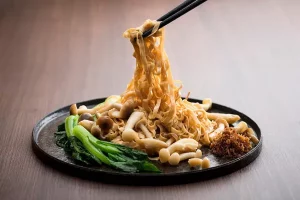
Key Features of Mee Pok:
Noodle Type: The noodles used in Mee Pok are flat and slightly wider than traditional egg noodles. They have a soft yet chewy texture that pairs well with the accompanying ingredients.
Preparation: Mee Pok noodles are usually boiled until they are tender yet retain a pleasant bite. They are then drained and rinsed with cold water to prevent them from sticking together.
Sauce: Mee Pok is often served with a flavorful sauce that is both savory and slightly spicy. The sauce includes ingredients like soy sauce, chili sauce, vinegar, and sometimes a touch of lard for added richness.
Ingredients and Variations:
Toppings: Mee Pok is typically topped with a variety of ingredients. Common choices include minced pork, fish cake slices, fish balls, and sometimes prawns or squid.
Vegetables: To add freshness and crunch, blanched vegetables like bean sprouts and leafy greens are often added to Mee Pok.
Garnishes: Chopped scallions and fried shallots are commonly used as garnishes to enhance the flavors and textures of the dish.
4. Hand-Pulled Noodles (La Mian)
Hand-pulled noodles, known as “La Mian” in Chinese, are a mesmerizing and intricate culinary art that originates from China. This traditional method of noodle-making involves skillfully stretching, folding, and pulling dough to create long, thin strands of noodles.
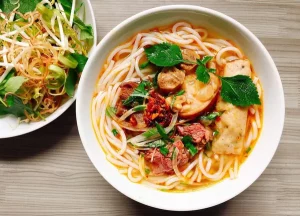
The Process of Making Hand-Pulled Noodles (La Mian):
Dough Preparation: The process begins with preparing a simple dough made from wheat flour, water, and sometimes a pinch of salt. The dough is kneaded until it’s smooth and elastic.
Resting: The dough is allowed to rest for a period of time, which makes it easier to work with and gives the gluten in the dough time to relax.
Stretching and Folding: The dough is then stretched and folded repeatedly, using a specific technique. This process helps develop the dough’s elasticity and creates the characteristic chewy texture of La Mian.
Pulling: The most awe-inspiring part of the process is the pulling of the dough. The noodle master takes a portion of the dough and begins to stretch and pull it into thin strands. The dough is repeatedly stretched, twisted, and folded over itself, creating multiple layers of noodles.
Variations: Depending on the desired thickness and texture of the noodles, the noodle master can adjust the pulling and stretching process. This is where the expertise and experience of the noodle maker truly shine.
Cooking: The freshly pulled noodles are quickly boiled in hot water for a very short period of time, as they cook extremely fast due to their thinness.
La Mian Dishes and Variations:
La Mian can be enjoyed in various dishes, each offering a unique flavor profile:
Beef Noodle Soup: One of the most famous dishes featuring La Mian is “Beef Noodle Soup.” The tender hand-pulled noodles are served in a rich broth with slices of braised beef, vegetables, and fragrant spices.
Spicy Dan Dan Noodles: This dish features hand-pulled noodles served with a spicy, nutty sauce, minced meat, and Sichuan peppercorns, creating a bold and flavorful experience.
Soy Sauce Noodles: Simple yet delightful, this dish features La Mian tossed in a savory soy sauce-based dressing with various toppings such as scallions, garlic, and sometimes vegetables.
Stir-Fried Noodles: In this variation, hand-pulled noodles are stir-fried with a combination of vegetables, protein, and savory sauces, creating a satisfying and quick meal.
See Also: How to Make Authentic Chinese Dry Noodles: A Step-by-Step Guide
5. Oil Noodles (You Mian)
Oil noodles, known as “You Mian” in Chinese, are a type of Chinese noodle that distinguishes itself with its rich flavor and distinctive preparation method. Unlike many other noodle varieties, You Mian noodles are coated in oil before cooking, giving them a glossy appearance and a satisfyingly smooth texture. This style of noodles is particularly popular in Fujian and Guangdong provinces of China and offers a delicious and unique twist on traditional noodle dishes.
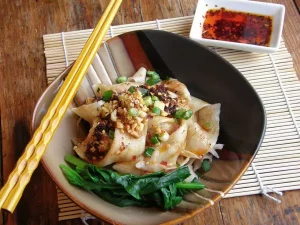
Characteristics of Oil Noodles (You Mian):
Texture: You Mian noodles have a glossy and slippery texture due to the oil coating. They are slightly chewy and have a delightful mouthfeel.
Preparation: The key feature of You Mian noodles is the coating of oil before cooking. This step not only gives the noodles their characteristic appearance but also prevents them from sticking together during cooking.
Ingredients: You Mian noodles are typically made from wheat flour, water, and salt. The dough is kneaded until it’s smooth and elastic before being rolled out and cut into noodles.
Cooking and Serving:
Boiling: After the noodles are cut, they are usually boiled in water until they’re cooked to the desired level of doneness. The oil coating prevents them from becoming overly sticky or clumping together.
Serving: Once cooked, You Mian noodles can be served in a variety of ways. They are often included in soups or stir-fried dishes, absorbing the flavors of the accompanying ingredients.
Variations and Dishes:
You Mian Soup: In this dish, You Mian noodles are served in a clear broth along with various toppings such as vegetables, meat, and sometimes seafood. The smooth texture of the noodles pairs well with the comforting warmth of the soup.
Stir-Fried You Mian: Stir-fried You Mian noodles are prepared by quickly stir-frying the cooked noodles with vegetables, protein, and savory sauces. The oil coating ensures that the noodles remain separate and don’t clump together during stir-frying.
Seafood You Mian: This variation features You Mian noodles cooked with an assortment of fresh seafood like shrimp, squid, and fish, creating a seafood-infused delight.
6. Knife-Cut Noodles (Dao Xiao Mian)
Knife-cut noodles, known as “Dao Xiao Mian” in Chinese, are a traditional and rustic type of noodle that stands out for its handmade and irregularly shaped appearance. This noodle variety is crafted by skillfully cutting and shaping the dough with a knife, resulting in noodles with a unique texture and an authentic homemade feel.
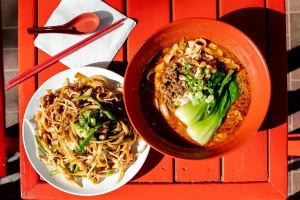
Characteristics of Knife-Cut Noodles (Dao Xiao Mian):
Handcrafted: The defining feature of Dao Xiao Mian is the method of noodle-making, which involves manually cutting the dough into uneven, irregular strips. This handcrafted approach gives the noodles a rustic charm.
Texture: Dao Xiao Mian noodles have a slightly rough and uneven texture, allowing them to capture and hold onto sauces and broths effectively.
Preparation: The dough for Dao Xiao Mian is typically made from wheat flour, water, and sometimes a bit of salt. It’s kneaded to develop its elasticity before being rolled out and cut.
Cooking and Serving:
Boiling: Once the dough is cut into noodles, they are boiled in water until they’re cooked to the desired consistency. The cooking time may vary depending on the thickness of the noodles.
Serving: Knife-cut noodles are often used in hearty soup dishes or stir-fries, as their uneven texture can help absorb the flavors of the accompanying ingredients.
Variations and Dishes:
Lamb Noodle Soup: A popular dish that features Dao Xiao Mian is lamb noodle soup. The noodles are served in a flavorful broth with tender pieces of lamb, vegetables, and fragrant spices.
Stir-Fried Knife-Cut Noodles: In this preparation, the cooked noodles are stir-fried with a combination of vegetables, protein, and savory sauces. The noodles’ rough texture allows them to soak up the flavors of the stir-fry.
7. Long Life Noodles (Yi Mein)
Long Life Noodles, known as “Yi Mein” or “E-fu Noodles” in Chinese, are a special type of noodle that holds deep cultural significance. As their name suggests, these noodles are often associated with longevity and are traditionally served during celebrations, birthdays, and other joyous occasions in Chinese culture. Beyond their symbolism, Yi Mein noodles offer a delightful culinary experience with their unique texture and ability to absorb flavors.
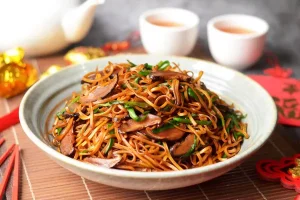
Characteristics of Long Life Noodles (Yi Mein):
Noodle Type: Yi Mein noodles are made from wheat flour and egg, giving them a rich and slightly chewy texture. They are typically round and thicker than regular egg noodles.
Preparation: The dough for Yi Mein noodles is usually rolled out, cut into wide strips, and then stretched gently to achieve their characteristic length.
Symbolism: Long Life Noodles are often served uncut to represent a long and unbroken life. The length of the noodles symbolizes longevity and is a way of conveying well wishes to those enjoying the dish.
Cooking and Serving:
Boiling: To prepare Yi Mein noodles, they are boiled in water until they are cooked to the desired level of doneness. Like other egg noodles, they cook relatively quickly.
Stir-Frying: After boiling, Yi Mein noodles are commonly stir-fried with various ingredients. The stir-frying process adds depth of flavor to the noodles and allows them to absorb the savory sauces and other components of the dish.
Variations and Dishes:
Birthday Noodles: Long Life Noodles are often served as part of birthday celebrations to wish the person a long and prosperous life. These noodles are usually stir-fried with vegetables and protein, creating a colorful and meaningful dish.
Soy Sauce Noodles: A simple preparation involves stir-frying the cooked Yi Mein noodles with soy sauce and a touch of oyster sauce. This minimalist approach allows the natural flavor of the noodles to shine.
Seafood and Vegetable Stir-Fry: Yi Mein noodles can be stir-fried with a variety of ingredients such as shrimp, scallops, bok choy, and mushrooms, creating a dish that’s both visually appealing and full of flavors.
8. Wonton Noodles
Wonton noodles, also known as “Wantan Mee” in Chinese, is a beloved and iconic dish that offers a delightful combination of flavors, textures, and culinary traditions. This dish is a staple in various regional Chinese cuisines, particularly in Cantonese and Hong Kong culinary traditions.
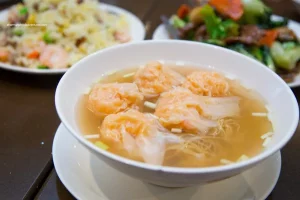
Components of Wonton Noodles:
Wontons: Wontons are small dumplings made from a thin dough that’s typically filled with a mixture of minced meat (usually pork or shrimp) and seasonings. The filled dough is then folded and sealed into various shapes, often resembling little envelopes or purses.
Noodles: The noodles used in wonton noodles are usually egg noodles, which have a slightly chewy and springy texture. The noodles serve as a base for the dish, providing a satisfying foundation.
Broth or Sauce: Wonton noodles can be enjoyed either in a clear soup broth or a savory sauce. The choice of broth or sauce can vary depending on regional preferences.
Types of Wonton Noodles:
Wonton Noodle Soup: In this version, the wontons are cooked and served in a flavorful broth. The broth can be a clear chicken or pork-based broth, sometimes with additional seasonings and aromatics.
Dry Wonton Noodles: This variation features cooked wontons and noodles tossed in a savory sauce. The sauce often includes soy sauce, oyster sauce, and sometimes chili sauce or sesame oil.
9. Rice Vermicelli (Mi Fen)
Rice Vermicelli, known as “Mi Fen” in Chinese, is a type of thin noodle made from rice flour.
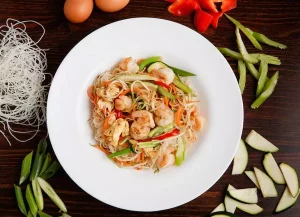
Characteristics of Rice Vermicelli (Mi Fen):
Appearance: Rice Vermicelli noodles are thin, translucent, and often white when dry. When cooked, they turn soft and slightly transparent.
Texture: These noodles have a smooth and tender texture that’s distinct from wheat-based noodles. They have a pleasant chewiness when cooked properly.
Ingredients: The main ingredient of Rice Vermicelli is rice flour, making them suitable for those who follow gluten-free diets.
Cooking and Serving:
Preparation: Rice Vermicelli is typically sold in dried bundles. Before cooking, the noodles need to be soaked in hot water to soften them. The soaking time is usually short, around 3 to 5 minutes, to prevent them from becoming overly soft.
Usage: Once soaked, Rice Vermicelli can be used in a variety of dishes. They’re commonly added to soups, stir-fries, salads, and spring rolls.
Dishes and Variations:
Vermicelli Soup: Rice Vermicelli is often used in clear broth-based soups, such as Vietnamese pho or Thai tom yum soup. The noodles absorb the flavors of the broth, creating a comforting and flavorful dish.
Stir-Fried Vermicelli: In this dish, softened Rice Vermicelli is stir-fried with an assortment of ingredients such as vegetables, meat, seafood, and sauces. The quick cooking time of the noodles makes stir-frying a convenient and tasty option.
Rice Paper Rolls: Rice Vermicelli is a key ingredient in fresh spring rolls, where they’re combined with fresh vegetables, herbs, and protein, all wrapped in rice paper and served with dipping sauces.
10. Thick Rice Noodles (Lai Fun)
Thick rice noodles, known as “Lai Fun” in Chinese, are a type of noodle made from rice flour. These noodles are wider and thicker compared to other rice noodles, and they have a satisfyingly chewy texture that makes them ideal for absorbing flavors and holding up well in various dishes. Lai Fun is a versatile ingredient commonly used in soups, stir-fries, and hearty noodle dishes across various Asian cuisines.
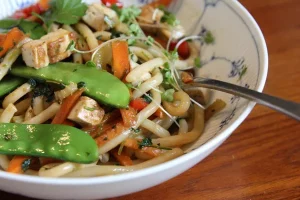
Characteristics of Thick Rice Noodles (Lai Fun):
Appearance: Lai Fun noodles are wide, flat, and thicker than other rice noodles. They are usually sold dried and require soaking before cooking.
Texture: The chewy and robust texture of Lai Fun sets them apart from thinner rice noodles. They retain their texture even when cooked, making them well-suited for dishes with bold flavors and rich sauces.
Ingredients: Thick rice noodles are made primarily from rice flour and water, making them a gluten-free option.
Dishes and Variations:
Rice Noodle Soup: Lai Fun is commonly used in noodle soups, such as the famous Malaysian dish “Curry Laksa.” The wide and chewy noodles soak up the flavors of the broth and pair well with rich and aromatic curries.
Stir-Fried Lai Fun: In this dish, the soaked Lai Fun noodles are stir-fried with a mixture of vegetables, protein, and sauces. The noodles’ texture and size make them ideal for holding up to stir-frying without becoming overly soft.
Lai Fun with Black Bean Sauce: A classic Cantonese preparation involves stir-frying Lai Fun with a savory black bean sauce, along with vegetables and your choice of protein.
11. Flat Rice Noodle (Ho Fun)
Flat rice noodles, known as “Ho Fun” in Chinese, are a popular type of noodle made from rice flour. These wide, flat noodles are valued for their smooth and silky texture, making them a versatile choice for a wide range of dishes in various Asian cuisines. Ho Fun is particularly well-known for its use in stir-fries and noodle soups, where its ability to absorb flavors and sauces shines.
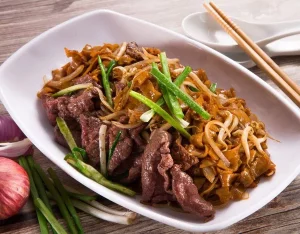
Characteristics of Flat Rice Noodles (Ho Fun):
Appearance: Ho Fun noodles are wide, flat, and usually translucent when fresh. They can vary in width, with some versions being broader than others.
Texture: The hallmark of Ho Fun is its smooth and silky texture. This quality allows the noodles to absorb sauces and flavors effectively.
Ingredients: Ho Fun noodles are primarily made from rice flour and water, and they are gluten-free, making them suitable for individuals with dietary restrictions.
Dishes and Variations:
Beef Chow Fun: Perhaps one of the most famous dishes featuring Ho Fun is “Beef Chow Fun.” This Cantonese dish consists of stir-fried Ho Fun noodles with tender slices of beef and often includes scallions and bean sprouts. The noodles absorb the savory sauce and provide a delightful contrast to the beef.
Ho Fun Soup: In this dish, the wide and silky Ho Fun noodles are served in a clear broth, often with ingredients like shrimp, chicken, vegetables, and aromatics. The noodles absorb the flavors of the broth, creating a comforting and satisfying soup.
Stir-Fried Ho Fun: The versatility of Ho Fun shines in stir-fries. The noodles can be stir-fried with a medley of ingredients, such as vegetables, seafood, or meat, along with sauces like soy sauce or oyster sauce.
12. Silver Needle Noodles (Yin Zhen Fen)
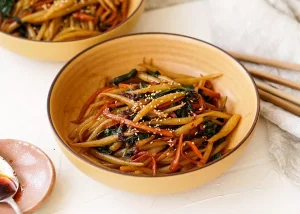
Aside from the name “Silver Needle Noodles”, many people often refer to Yin Zhen Fen as “Rat Noodles” since they resemble a rat’s tail. Yin Zhen Fen enjoys massive popularity in China, Hong Kong, and many Southeast Asian countries despite having an unconventional name.
This type of noodles requires two components, including rice flour and water. However, in some cases, the makers can add cornstarch to the mixture to thicken up the consistency of the dough, creating a very spongy texture.
Yin Zhen Fen is often available fresh on the street, so you can easily buy those noodles for your meals. This delicacy is quite versatile in stir-fries or noodle soup dishes.
13. Loh Shi Fun (Silver Needle Noodles)
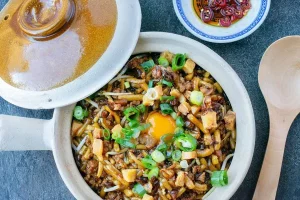
Most noodles are long, but Silver Needle noodles are not. They are just about 5 cm long and are very thick. The strands are made of ground rice flour and water. The flour comes from either glutinous or non-glutinous rice. Some cooks use cornstarch to make them chewier.
You should note that Silver Needle noodles are only available in fresh form. You can buy it directly at noodle vendors or get the commercial products at grocery stores.
A dish with Silver Needle noodles is a fulfilling meal that can be served as a delicious Chinese breakfast, lunch, and dinner or as a side dish.
People use it to make noodle soup and stir-fried dishes. Notably, it is an ingredient of a clay-pot dish called “Clay-Pot Lao Shu Fen”.
See Also: The Rich Variety of Chinese Noodles: A Comprehensive Guide
Regional Variations:
Chinese noodles vary greatly from region to region, reflecting the diverse culinary traditions of the country:
Northern China: Wheat-based noodles like hand-pulled noodles and scissor-cut noodles are popular due to the wheat-heavy diet of this region.
Southern China: Rice noodles are a staple in Southern cuisine, appearing in dishes like rice noodle rolls and congee.
Sichuan Province: Known for its spicy cuisine, Sichuan offers fiery noodle dishes like Dan Dan noodles and spicy cold noodles.
Shaanxi Province: Biángbiáng noodles, named after the sound of the dough being slapped against a table, are a unique specialty of this region.
Hong Kong: The bustling city is famous for its wonton noodles and Hong Kong-style egg noodles.
See Also: All About Frozen Noodles: An Ultimate Guide
Conclusion:
Chinese noodles are a testament to the rich culinary heritage of China, capturing the essence of different regions and traditions in every bite. Their versatility, symbolism, and cultural significance make them an integral part of Chinese cuisine that continues to captivate food enthusiasts around the world. Whether enjoyed in a street-side stall or a gourmet restaurant, Chinese noodles offer a delightful journey through flavors, textures, and history.

